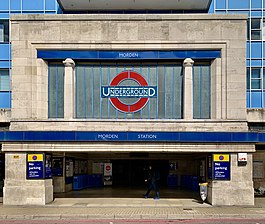| Morden | |
|---|---|
 The station entrance | |
| Location | Morden |
| Local authority | Merton |
| Managed by | London Underground |
| Owner | London Underground |
| Station code(s) | MDN[1] |
| Number of platforms | 5 (facing 3 rails) |
| Accessible | Yes[2] |
| Fare zone | 4 |
| London Underground annual entry and exit | |
| 2019 | |
| 2020 | |
| 2021 | |
| 2022 | |
| 2023 | |
| Railway companies | |
| Original company | City and South London Railway |
| Key dates | |
| 13 September 1926 | Opened |
| Other information | |
| External links |
|
| Coordinates | 51°24′08″N 0°11′41″W / 51.4022°N 0.1948°W |
Morden is a London Underground station in Morden in the London Borough of Merton. It is the southern terminus of the Northern line, and is the most southerly station on the Underground network. It is located on London Road (the A24), and is in Travelcard Zone 4. Nearby are Morden Hall Park and Morden Park.
The station was one of the first modernist designs produced for the London Underground by Charles Holden. Its opening in 1926 contributed to the rapid development of new suburbs in what was previously a rural part of Surrey; the population of the parish increased ninefold in the decade 1921–1931.
- ^ "Station Codes" (PDF). Transport for London. Retrieved 23 September 2021.
- ^ "Step free Tube Guide" (PDF). Transport for London. April 2021. Archived (PDF) from the original on 15 May 2021.
- ^ "Station Usage Data" (XLSX). Usage Statistics for London Stations, 2019. Transport for London. 23 September 2020. Archived from the original on 9 November 2020. Retrieved 9 November 2020.
- ^ "Station Usage Data" (XLSX). Usage Statistics for London Stations, 2020. Transport for London. 16 April 2021. Retrieved 1 January 2022.
- ^ "Station Usage Data" (XLSX). Usage Statistics for London Stations, 2021. Transport for London. 12 July 2022. Retrieved 7 September 2022.
- ^ "Station Usage Data" (XLSX). Usage Statistics for London Stations, 2022. Transport for London. 4 October 2023. Retrieved 10 October 2023.
- ^ "Station Usage Data" (XLSX). Usage Statistics for London Stations, 2023. Transport for London. 8 August 2024. Retrieved 16 September 2024.
